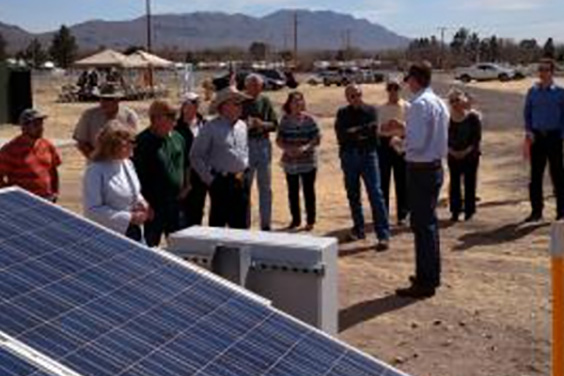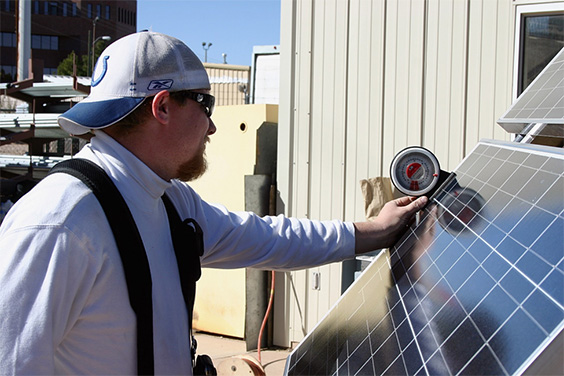KIT CARSON RURAL ELECTRIC COOPERATIVE
Kit Carson Rural Electric Cooperative on their path to achieve 100 percent daytime solar production.
Kit Carson Electric Cooperative (KCEC), based in Taos, N.M., is on a journey to attain 100 percent daytime solar energy production by 2022. This extremely innovative and challenging solar initiative will install up to 35 megawatts by harnessing the energy from the sun. KCEC is strategically placing the solar arrays throughout the Enchanted Circle for reliable and resilient energy generation. For grid modernization, KCEC is integrating its broadband network into the electrical system for full solar array control. KCEC is collaborating with northern New Mexico pueblos, municipalities, and communities to complement and enhance economic development opportunities. KCEC is also utilizing local labor to build the solar installations. Finally, KCEC is committed to providing Solar Energy for All.
What tools, resources or financing did you use to establish your project?
KCEC is the first cooperative to buy out of its power contract from Tri-State Generation and Transmission Cooperative. Guzman Renewable Energy Partners (GREP) became KCEC’s new energy provider. GREP is an active partner in reaching the renewable energy goals set by CEO Luis A. Reyes, Jr. and the Board of Trustees. GREP and KCEC have secured financing through a third-party developer for the 35-megawatt solar initiative and other potential energy storage projects.
In 2010, Kit Carson Technologies (KCT), a division of KCEC, procured $64 million dollars in a federal loan/grant from the America Recovery and Reinvestment Act to construct an extensive fiber network that serves Kit Carson’s service area. KCT’s reliable broadband network offers rural communities up to gigabit speeds and allows KCEC to create two-way communication between energy storage, solar arrays, and the electrical grid. Ensuring that innovative solar projects are integrated with a fiber network is imperative for the future of renewable energy.
What benefits have you realized?
KCEC’s goal to reach 100 percent daytime solar by 2022 brings endless benefits to north-central New Mexico’s rural communities—known as the Enchanted Circle. First, stabilized affordable electric rates allow members and businesses to forecast and plan for the future. Both public and private entities can market the advantages of 100 percent daytime solar. KCEC is laying the foundational infrastructure to support economic and community development with each unique community. The solar energy produced by KCEC will positively impact the environment, creating greener energy for members. In addition, KCEC is committed to hire and promote hiring regional employees and contractors for on projects to construct facilities.
What challenges did you overcome to implement your project?
The first challenge was the contractual barriers to renewable power generation. Second, was the strategic placement of the arrays and connecting the power generation into a smart grid. Third, KCEC continues to educate its members about the importance of working with the cooperative to generate renewable energy for all, rather than solely for individuals. This is the purpose of solar, wind, and other forms of renewable energy. All people, regardless of their income, must have access to the benefits of renewable energy.
As a utility, KCEC is constructing these arrays in areas suitable for optimal productivity and operational benefit. Instead of building one massive 35-megawatt array, KCEC is placing multiple arrays throughout its service territory to take advantage of different weather conditions. If it’s a cloudy day in Taos County, KCEC will still be generating electricity in Rio Arriba and Colfax counties. Because of the strategic placement of the solar arrays, KCEC members will not have to incur the cost of upgrading infrastructure. Finally, property and GRT taxes will be distributed amongst every KCEC community for schools, municipal, and tribal projects.
KCEC has found a path to pursue renewable energy as a cooperative and is leading the way towards the future Americans and New Mexican desire.
What advice would you give neighboring communities who are trying to implement a similar project?
Identify your Community’s Visions and Goals for Renewable Energy: Collectively, agree on the needs and wants of your community. Is your community interested in renewable energy? If so, address the challenges and benefits of incorporating renewable energy into your community. Use your energy experts to devise a strategy and plan that will work within your geographical boundaries.
Community Inclusion: Create a process that will provide solar energy for residents, pueblos, municipalities, and schools in your community. This allows every person to embark on the path of renewables or as KCEC says, “Solar Energy for All.”
Partner with a Cooperative Utility, Organization or Entity: Align with a local cooperative utility and organizations that have the resources and tools to implement a renewable project. KCEC encourages the participation of local municipalities and nonprofit renewable groups. KCEC recommends communities find suitable partners that share the same vision and can assist in planning, construction and financing.
Design a Feasible Renewable Deployment Plan: Work with your local utility to design a feasible renewable deployment plan. For instance, where renewable energy generation and storage resources need to be located so that your community has a reliable energy grid system for everyone.
Thank your senator and political leaders: For passing legislation that enables a clean, renewable future for our children. You can also challenge them to take the next step.


